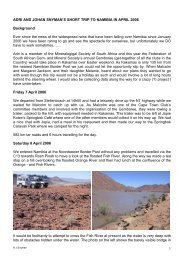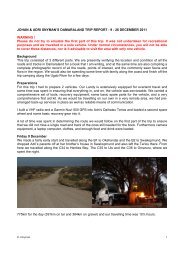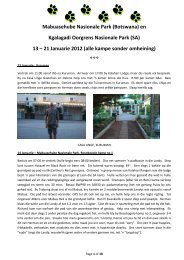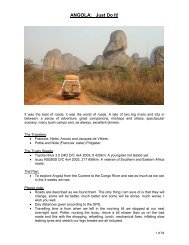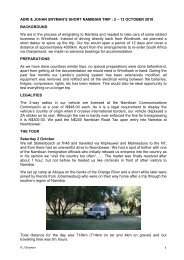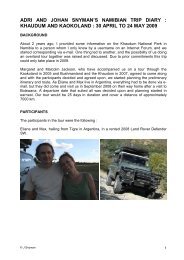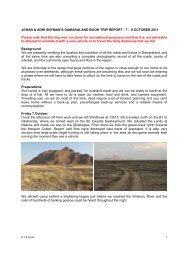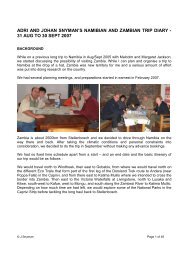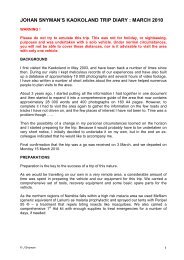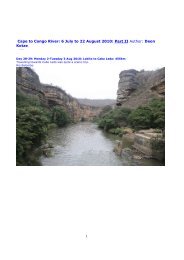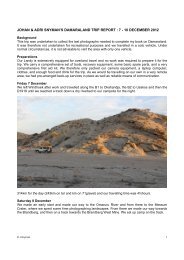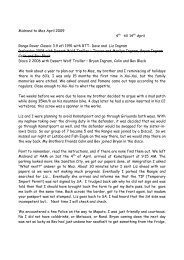Create successful ePaper yourself
Turn your PDF publications into a flip-book with our unique Google optimized e-Paper software.
<strong>Fw</strong>: <strong>Ons</strong> <strong>Angola</strong> <strong>trip</strong> <strong>report</strong>.<br />
1 of 14 2009/04/06 01:03 PM<br />
Subject: <strong>Fw</strong>: <strong>Ons</strong> <strong>Angola</strong> <strong>trip</strong> <strong>report</strong>.<br />
From: "T.D. du Plessis" <br />
Date: Wed, 1 Apr 2009 11:28:47 +0200<br />
To: <br />
Hennie<br />
Ek het al heelwat male julle Web tuiste besoek en gebruik onderandere vir <strong>Angola</strong> info, hierby is my terugvoering van ons Des<br />
vakansie in <strong>Angola</strong> as jy dit wil plaas ( op aanbeveling van Anton van Schalkwyk) - laat weet maar as jy dit wil gebruik of as jy dalk<br />
die foto's in ander formaat soek. Ek weet nie of dit nodig is om te noem nie maar SA4x4 tydskrif gaan dit ook plaas.<br />
Verskoon die paar tik foute wat daar dalk nog mag wees.<br />
Groete<br />
T.D. du Plessis<br />
Our family “ADVENTURE” to <strong>Angola</strong><br />
There is a curse on the word “adventure” which brings bad luck when ever I use it to describe an<br />
outing, well this one is behind us and it was a true ADVENTURE.<br />
It all started in the 2 nd half of 2008 when we decided to go to <strong>Angola</strong>, my wife and I with kids ages 5,7<br />
and 9 and our friends a couple. A lot of research was done on Google, and information was gathered<br />
from people who had caught the fish, traveled the routes and ate the food.<br />
I formed the opinion that you can go to <strong>Angola</strong> for 2 reasons. 1. for fishing, 2. for exploring, we went<br />
for the 2 nd but took the rods with just in case.<br />
Our adventure started with a bang, not with a good one but with the sound your car door makes when<br />
the children didn’t close the door after climbing out to open a farm gate and you drive through it<br />
closing the door with the fence pole, luckily it was only a small dent and scratch, this happened as we<br />
had to detour because we missed a turn off and ended up in front of the gate to Etosha, you can imagine<br />
what feelings this created. We set up camp at the Kunene River Lodge and had some good bird<br />
sightings. I added the Rufus Tailed Palm Thrush in his clay nest to my life list.<br />
Day 1<br />
Our friends arrived and we all had to refuel at Ruacana only to find out that there was<br />
a price decrease coming so there was no petrol or diesel as the owner was waiting for
<strong>Fw</strong>: <strong>Ons</strong> <strong>Angola</strong> <strong>trip</strong> <strong>report</strong>.<br />
2 of 14 2009/04/06 01:03 PM<br />
the price decrease before ordering fuel. We detoured 70 km to Otapi and after leaving<br />
I discovered that someone did a closer inspection of our goods on the back of the<br />
vehicle, but luckily nothing was stolen. We also discovered that our front number<br />
plate was lost and this before the Ruacana border crossing, well we trust God in our<br />
journeys and off we went and the crossing went all well, we were inspected and the<br />
cars looked through but didn’t have to unpack at all. At the Namibian border the<br />
officials could not find my engine number and eventually gave up the search,<br />
fortunately we had police clearance on our vehicles and off we went. We drove on and<br />
found a camp spot at about 17H00 next to a slow flowing pictures stream. We were in<br />
<strong>Angola</strong>, celebrating and spirits were high.<br />
Day 2<br />
We were in deep Mopane fields and the scenery was marvelous with granite mountain ranges covered<br />
in green as far as the eye can wonder. We left at 09h00 and traveled 200 km for the day passed<br />
Oncucua, setting up camp at 17h30 next to the Elalla River. The day was full of river crossings, some<br />
dry and some wet, but nothing to thought to handle. Upon stopping to set up camp our companion’s<br />
vehicle wouldn’t start, this sent some shivers up our spines, luckily we discovered that it was due to a<br />
blown battery which seems to have been tightened to much, we used the 2 nd battery to start the engine<br />
and was back in the spirit of seeking “adventure”. During the day we met some Himbas and discovered<br />
that even they were submitting to the modern life by using motorcycles to travel between towns and<br />
villages, what a sight to see a Himba on a motorcycle! Our camp S1644226 EO1314964.
<strong>Fw</strong>: <strong>Ons</strong> <strong>Angola</strong> <strong>trip</strong> <strong>report</strong>.<br />
3 of 14 2009/04/06 01:03 PM<br />
Day 3<br />
We left at 08h00 and took the northern route marked as “not recommended” on T4A,<br />
the route it self was much overgrown and in someplace only a single spoor leading<br />
through Mopane and thorn bushes, the route it self was not to difficult but had some<br />
more challenging river crossings since it was not used that often. The worst was the<br />
screeching noises of rubbing bushes under and on the side of the vehicles, it made me<br />
consider VPS protection but it was to late to spill any tears now. The last river<br />
crossing at Pediva was quite a rush with much more water and bigger rocks hidden<br />
under the water surface. This track was much desolated and getting back to the main<br />
track gave one the feeling of being back in civilization although we where still far from<br />
anything. We traveled 108 km for the day and set up camp at 17h30 in a lovely plain<br />
scattered with granite outcrops much the same as at Spitskoppe back home (S1615029
<strong>Fw</strong>: <strong>Ons</strong> <strong>Angola</strong> <strong>trip</strong> <strong>report</strong>.<br />
4 of 14 2009/04/06 01:03 PM<br />
EO1232197) Surprise for the day was an Afrikaans speaking Himba from Windhoek<br />
and many tweety birds – as we started calling al the Himba children shouting for<br />
sweets, sweets, sounding like tweets, tweets.<br />
Day 4<br />
We are back on the road at 08h45 and visit the now almost famous <strong>Angola</strong> Welwitchia, and place our<br />
specially prepared stones on the stone pile that we brought with from Windhoek. (A bit of a turn down<br />
was that some people are turning it into a waste pile, and little did we know that we were still in clean<br />
country) We reached the Arco Lake with its mud houses and palm leave roofs lining the edge of the<br />
lake creating a beautiful sight, after this we had to cross the app. 200m wide now in semi flood river<br />
feeding the lake, this didn’t pose any problems as it was very wide but shallow with only some mud<br />
towards the end and comparing it with the “sinkpad” from the Welwitchia to here it was a breeze. We<br />
arrived at Tombua, drew money at the BOB, filled up our water from the local municipality offices<br />
underground water tank and replaced the battery (@ N$ 1 700-00 ouch). Thanks to Mr. Ressamo and<br />
some locals who helped us during their lunch break. Tombua is clean but has a nasty fish smell and<br />
after some nice photo opertunities in their harbor with old fishing boats lying in pain and decay we set<br />
of to find a camp. There was also no diesel available. Be prepared for the little dune as you leave<br />
Tombua, this one doubled our hart beat and by the behavior of the local kids I could see that we were<br />
not the first ones to get stuck and give it another high revolution go. We set up camp at a little lagoon<br />
just south of the first ship wreck and were not to far from 2 fishermen making a living on the beach.
<strong>Fw</strong>: <strong>Ons</strong> <strong>Angola</strong> <strong>trip</strong> <strong>report</strong>.<br />
5 of 14 2009/04/06 01:03 PM
<strong>Fw</strong>: <strong>Ons</strong> <strong>Angola</strong> <strong>trip</strong> <strong>report</strong>.<br />
6 of 14 2009/04/06 01:03 PM<br />
Day 5, 6, 7<br />
Time to take out the fishing rods, my first catch was a Leer Fish, 2 nd on line was some small bugger<br />
that stung me in the finger, my hand started to pop up but as the fish were biting there was no time for<br />
medication now. Next was a shad, after inspecting and showing of its nice teeth it got hold of the same<br />
finger and bit me right next to the place were I just got stung, now it was blood all over, hey but<br />
nothing that an old rag cant temporarily fix, the fish are still here, the kids caught some smaller fish<br />
and all seemed to quiet down when next I hooked a “sand haai” in the back, while retrieving my<br />
spinner from it’s back it electrified me sending me off with a huge jump! This was if for the day, I had<br />
my share, stung, bitten and electrocuted I packed up and settled down for the next few days which<br />
passed by with spectacular waves filled with phosphor in the evenings and a lake full of jumping fish.<br />
The kids enjoyed the lake and the wife’s caught up on their tans.<br />
Day 8<br />
Our batteries were charged and we left at 10hoo heading for Forado Camp. Next was the Orca Lake,<br />
this is worth a visit as you get to stretch your legs and see some beautiful scenery on a guided tour, this<br />
can become a bird watching paradise. We stopped over at Namibe to refuel, here we paid N$ 6-50 /l, I<br />
think we were done in compared to the rest of the countries fuel prices, which was in the range of N$<br />
3-50/l. Namibe was a bustling town with a packed water front area; this must have been a very nice<br />
town judging by the layout, architecture, harbor, big palms and wide streets. We reached the Forado<br />
camp turn off at about 14h30. Don’t bother turning off, Forado Camp is none existing, we reached two<br />
dead ends, the 2 nd after following the river with vague tracks and a lot of rocks, boulders etc covering<br />
our way and ending in a dead end with huge boulders which washed into the river and a chain blocking<br />
the once excising road. On our way we passed a painted sign reading “my beach”, what a nice piece of<br />
dirty property, a pictures quiet little sand beach surrounded by huge cliffs on both sides, a small<br />
dammed up river on the one side for fresh water, and some dilapidated stables, ruins of an old house<br />
with a clay bake oven still standing and 2 old fisherman boats lying in decay. Two locals inhabit some<br />
old living quarters it seems and with their pigs and goats seem to make a living here, tired and<br />
frustrated we set up camp at 17H00 S1444152, EO1217294.
<strong>Fw</strong>: <strong>Ons</strong> <strong>Angola</strong> <strong>trip</strong> <strong>report</strong>.<br />
7 of 14 2009/04/06 01:03 PM
<strong>Fw</strong>: <strong>Ons</strong> <strong>Angola</strong> <strong>trip</strong> <strong>report</strong>.<br />
8 of 14 2009/04/06 01:03 PM<br />
Day 9<br />
We leave at 7h30 with low morals after not finding Forado and looking forward to some nice ablusions<br />
and some decent camping sites for a change. Our aim is to reach Cabo Lebo with two camp sites<br />
marked on T4A. The road leads through some beautiful mountain passes and with new tar roads<br />
under our wheels time flied by. We passed the lush green town of Bentiaba and other villages, here we<br />
also met up with some other Namibians who where on a fishing <strong>trip</strong>. The villages are all small but<br />
pictures, with mangos and bananas in abundance. The road started to deteriate up to Lusira and then<br />
suddenly the tar ended and changed to a gravel road under construction. We were in the mountains<br />
and I mentioned that it seems that the warning from the other travelers about a “van Zyls” pass<br />
waiting for us was unfounded. We then passed a road construction camp and suddenly found ourselves<br />
in first gear low range. We were averaging 4 km per hour for about four hours; my wife went from<br />
crying cracking to hysterical about the road situations. We set up camp next to the road at 17h00<br />
E1321450 EO1253524. We traveled about 250 km for the whole day. At least the surroundings were<br />
beautiful and no more tweety birds. Everybody was tired but having loads of fun.<br />
Day 10<br />
Today I lost all inabisions to take part in any more 4 x 4 competitions, trails or what else, I had my
<strong>Fw</strong>: <strong>Ons</strong> <strong>Angola</strong> <strong>trip</strong> <strong>report</strong>.<br />
9 of 14 2009/04/06 01:03 PM<br />
share for the year to come. We left camp at 7h30 and were met with oil drips in the roads where some<br />
diff or sump where repaired and a lot of rock to pass. We continued safely due to experience, slow low<br />
range driving and relying on a navigator for the best part of the morning. From Dumbe Grande the<br />
road improved through to Lobito. We topped up our water at a village borehole pump next to the road<br />
and passed some awesome seenary with valleys and mountains everywhere and dramatic sandstone<br />
formations. We where back on a new tar road from Benguela and now pushed for the camp site at<br />
Cabo Lebo, we arrived at 21h00 with the first indicated camp site leading to a road construction site,<br />
we set off for camp no 2 and descended down towards sea level. I was driving behind our companions<br />
and when I felt my car starting to slip I stopped to see if all was well with the road ahead. Then a call<br />
came over our radio “I’m stuck”. We were in a high tide plain and could hear the waves breaking not<br />
to far away. I walked over to the other car and was met by the sight of a bellied down to the earth 4x4,<br />
this was it! My wife wanted to go for help but my opinion was that we had the knowledge and know<br />
how and had to do this and get out ourselves. We had a winch on the stuck vehicle which we hooked up<br />
to my vehicle, dug some trenches in front of the four wheels and tried to winch out, no go. My vehicle<br />
was pulled in over the slippery mud so I re positioned to a small grassed area, we tried pulling him out<br />
with my vehicle but he was not moving an inch, I was only spinning on the spot. Hands in our hair<br />
mud in our shoes we re-assessed the situation and I remembered the LA sport video of lifting the<br />
vehicle with a high lift jack and pushing it out of the spoor. This gave me a new idea and off came the<br />
air jack. We dug into the clay below the spare wheel and inserted the jack, our vehicles were heavily<br />
loaded but we succeeded in achieving a lift of plus minus 2 cm just enough to brake the suction, we dug<br />
again in front of the wheels and used what we could to insert in front of the wheels, not much was<br />
around to be used. We winched again and this time had some progress forward – about 1 meter. We<br />
had about 15 meters to cover, we did this over and over and eventually we had one side of the car on<br />
the clay but the other side was still cutting thru the clay and into the water under the clay. We<br />
repeated the jacking digging and winching process for 3 hours and by now were covered in mud from<br />
head to toe! The surface we got stuck in was about 3 cm sand on top of a layer of clay of 30 cm thick<br />
followed by water embedded sand. Well we where unstuck and so proud of our accomplishment.<br />
Totally charged up we headed to a lodge indicated on the T4A and after waking everybody at about<br />
1h30 we were informed that there was no camping available and were given directions to Shalongo<br />
village about 10 minutes away. We set of to the village but could not find the turn of and after about 30<br />
min drive we turned around. I pulled into the village that was 10 min away and saw that a truck<br />
standing next to the road was blocking the entire gravel entrance road. We followed this road down to<br />
the beach and behold there was a new development with chalets and restaurant. The owner came down<br />
to meat us at 02h30 and it was good to hear and communicate in broken English for a change. We<br />
could camp there on the beach and at 03h00 the kids where in bed.
<strong>Fw</strong>: <strong>Ons</strong> <strong>Angola</strong> <strong>trip</strong> <strong>report</strong>.<br />
10 of 14 2009/04/06 01:03 PM<br />
Day 11, 12, 13 and 14<br />
We chilled out at our new found camp site, and apon inspecting our friend’s car found the winch fixing
<strong>Fw</strong>: <strong>Ons</strong> <strong>Angola</strong> <strong>trip</strong> <strong>report</strong>.<br />
11 of 14 2009/04/06 01:03 PM<br />
plate to be bent and the welding on the chasse behind the mounting brackets to be cracked. The setting<br />
of the camp is in a little bay but it is crowded by a fishing village next-door who seem to use the sea as<br />
there dumping ground with bottles, plastic bags, jackets being washed ashore regularly. But we still<br />
had a good swim. Ablutions had to be shared with all and had no doors and are still in a state of<br />
renovation. So hopefully things will improve soon. Bungalows are also available. Here we were<br />
fortunate to be joined by a new companion for the few days, we called him Woes, one of the local dogs<br />
who took us in and he regarded us as precious. He literally garded us and even went so far as to<br />
attacked one of the locals who he regarded as a nuisance at our camp, further he kept some drunks<br />
away, played with the kids and went with us for strolls on the beach, much to the dismay of the other<br />
local dogs. S0933201 EO1312077.<br />
Day 15<br />
We packed up and paid N$ 135-00 per day, what a very reasonable price. Next we headed for Mussulo,<br />
what a disappointment; we drove thru rubbish stench and thick sand expecting to find Franks place or<br />
other developments along the bay. Eventually we turned around and headed back as most of the<br />
buildings where in decay and new developments only starting in some places. Later on driving past<br />
Mussulo from the main land, it looked as if there where more development towards the end of the<br />
Island and we might have turned around to early. We drove through Luanda in about 3 hours without<br />
any pr0blems, thanks to T4A. It was amazing to see people living between and in so much rubbish.<br />
New developments are evident everywhere and with people still occupying dilapidated buildings. We<br />
went to the ship grave yard where the road has been turned into a borrow pit and the anxiety overcame<br />
my wife after driving thru Luanda as the scenery screened a place where one could be murdered and<br />
never found. We turned around and set of to find a place to camp as it was getting late. We traveled till<br />
after Catete and set up camp in the bushes next to the road with landmines in mind we treaded lightly.<br />
S0909364 EO1351657.
<strong>Fw</strong>: <strong>Ons</strong> <strong>Angola</strong> <strong>trip</strong> <strong>report</strong>.<br />
12 of 14 2009/04/06 01:03 PM<br />
Day 16<br />
We traveled thru Dondo, Quizenga, Cacuso, Pedras Negras. This road leads you through huge forests<br />
and some Kremetart forests that you can’t imagine the beauty off and past the outcrops of Pedras<br />
Negras which is truly amazing to see. We camped next to the road with a view of the Cuanza River.<br />
The roads are tarred and in a good condition up to Pungu Undonga where it changed to a good dirt<br />
road. S0939071 EO1455582
<strong>Fw</strong>: <strong>Ons</strong> <strong>Angola</strong> <strong>trip</strong> <strong>report</strong>.<br />
13 of 14 2009/04/06 01:03 PM<br />
Day 17<br />
We were in highway country again up to Lubango but the “go home” has bitten our companions. Very<br />
depressed I made the decision to rather head for the border and sleep over in Namibia than to spend<br />
time alone without any navigation in the Lobango area, as we had no Gps. We refueled in Lubango<br />
and headed home. If you are informed as we were that the road has been tarred from Lubango to<br />
Namibia do not believe it. They are busy with it but you literary hit the first pot holes and you have to<br />
travel next to, onto and wherever possible for a few hours. This got me into a laughing state as well as<br />
we were planning on a 3.5 hour drive to the border. It took 7 hours from Lubango to the border and at<br />
17h50 we whisked thru the <strong>Angola</strong> side – what and adventure – we where glad and sad to be home.<br />
Will I go again, yes, to see the Lubango area and more of the North and eastern areas just maybe<br />
taking a different road this time and some day the coast again.<br />
KM traveled 5900<br />
Water carried – 140 l between two cars<br />
I had 40 l diesel additional which was enough.<br />
Car Toyota D4D 4 x 4 with iron man suspension and added leave blade at the back.
<strong>Fw</strong>: <strong>Ons</strong> <strong>Angola</strong> <strong>trip</strong> <strong>report</strong>.<br />
14 of 14 2009/04/06 01:03 PM<br />
Problems, we were twice threatened to be locked up, once due to one drunk police officer and the other<br />
because of a miss interpretation of the language – I think El posso means passport and not driving<br />
license -, but other than that I felt it was save and found the people to be helpful. Little information is<br />
available and be self sufficient.<br />
Positively the country is in repair and it has beautiful vistas, mountains, mountain passes, escarpments,<br />
valley’s, rivers and forests, interesting ruins all the way and definitely worth the visit, buy your self an<br />
English to Portuguese phrase book, it is help full.<br />
Foot note: It is very important for all to be well informed and to be mentally prepared as the roads and<br />
every day situations can be very stress full and tiring.



